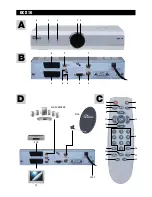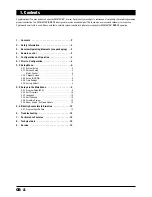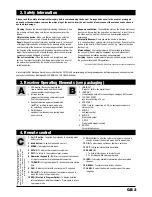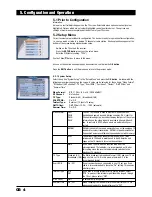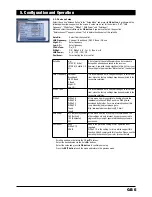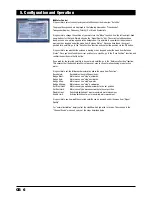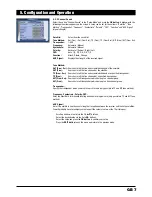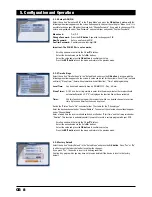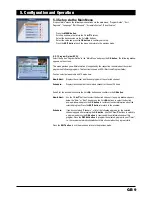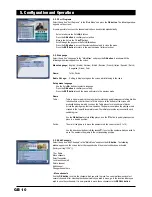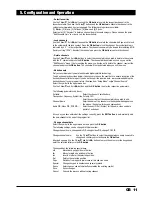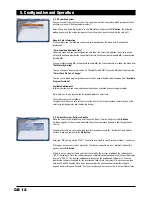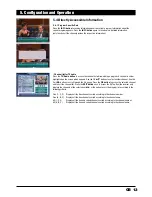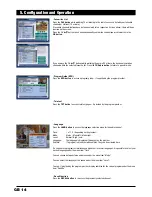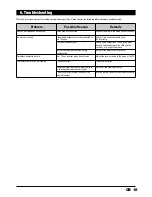
GB 4
5. Configuration and Operation
5.1 Prior to Configuration
Information:
A menu is a text field which appears on the TV screen. Selectable menu options are usually colour
highlighted. Options which are not colour highlighted cannot be altered or set. The options and
settings of most menus are explained at the bottom of your TV screen.
5.2 Setup Menu
Correct receiver setup includes its configuration. The device is ready for operation after configuration,
i.e. you can watch or listen to a desired TV channel or radio station. Short explanations appear at the
bottom of the screen during standard value setup.
•
Switch on the TV set and the receiver.
•
Press the SETUP button to access the setup menu.
•
Enter the PIN (factory setting: “1234”)
Use the CH
왖
/
왔
buttons to move in the menu.
As soon as the desired option/setup has been selected, confirm via the OK button.
Press the EXIT button to exit the menu and return to the previous mode.
5.2.1 System Setup
Select the option “System Setup” in the “Setup Menu” and press the OK button. A window with the
following menu items appears on the screen. A value can be selected for these items: “Video Format”,
“RF Channel (UHF channel)”, “TV Type”, “Scart RGB”, “Positioner”, “Teletext”, “GMT Offset” and
“Summer Time”.
Video Format:
NTSC / PAL I, B, G or K / SECAM/MULTI
RF Channel:
No function
TV Type:
Standard (4:3) / Broadband (16:9)
SCART RGB:
On / Off
Teletext Type:
Receiver / TV (basic TV setup)
GMT Offset:
GMT 12:00 ~ -12:00 (automatic)
Summer Time:
On / Off
Video Format:
PAL I
PAL B
PAL G
PAL K
The PAL TV standard is used in most Euro-pean countries,
Australia and some Asian and African countries. PAL, short for
Phase Alternating Line, describes the way that part of the colour
information on the video signal is reversed in phase with each
line. In contrast to NTSC, phase errors are automatically cor-
rected.
SECAM
SECAM is used in France and eastern Europe as the analogue TV
standard for colour transmission. SECAM is the abbreviation for
Sequentiel Couleur avec Mémoire (sequential colour with memory).
NTSC
The National Television Standards Committee (NTSC) was
introduced in 1954 and is mainly used in North America and
Japan as the TV standard for colour transmission.
Multi
If you own a TV set which can function with all of the
aforementioned TV standards, it is recommended not to alter
this setting since the receiver automatically switches to the
broadcast TV standard.
TV Type
Standard (4:3)
Broadband (16:9)
If a film is broadcast in broadband format (16:9) and your TV set
supports this, set 16:9 in this menu; otherwise 4:3 is the
recommended format.
Scart RGB
On / Off
If your receiver has been connected to your TV set via a Scart
cable, it is recommended to leave the “On” setting. This ensures
a better picture.
Teletext Type
STB
VBI
If you wish to access teletext directly via the receiver, select
“STB”. However, if the teletext signal should be looped through
the TV set, please select “VBI”.
GMT Offset
GMT
Is automatically recognised.
Summer Time
On / Off
When changing from standard time to summer time set to “On”,
when changing back to standard time set to “Off”.
Содержание DCX 10
Страница 1: ...Digital Satellite Receiver DCX 10 39730 OPERATING INSTRUCTIONS...
Страница 3: ......
Страница 19: ...GB 17...
Страница 20: ...9903973002 BDA GB 09 2005...


